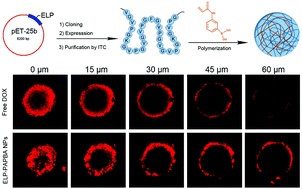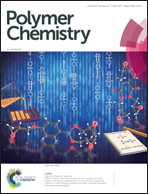Phenylboronic acid-incorporated elastin-like polypeptide nanoparticle drug delivery systems†
Abstract
Packaging hydrophobic drugs into nanoparticles can improve their aqueous solubility, tumor-specific accumulation and therapeutic effect. In this study, we prepared phenylboronic acid-incorporated elastin-like polypeptide (ELP) nanoparticles by polymerizing N-3-acrylamidophenylboronic acid (APBA) in the presence of ELP which was expressed from a plasmid with the ELP gene in Escherichia coli. It was found that phenylboronic acid-incorporated elastin-like polypeptide nanoparticles (ELP-PAPBA NPs) had a spherical shape with the size of 100 nm and were highly stable in an aqueous medium with a wide range of pH. The cellular uptake experiment showed that the ELP-PAPBA NPs could be rapidly taken up by single cells and multicellular spheroids (MCs). However, the cellular uptake of ELP-PAPBA NPs decreased dramatically when tumor cells were pretreated with free APBA or free sialic acid, suggesting the interaction between boronic acid-incorporated nanoparticles and overexpressed sialic acid in cancer cells. When loaded with the drug doxorubicin (DOX), the ELP-PAPBA NPs showed a loading content of about 10% and an encapsulation efficiency of about 85%. Bio-distribution and in vivo anticancer efficiency experiments revealed that DOX-loaded ELP-PAPBA NPs had a better tumor accumulation and penetration, lower heart side effects and significant superior anticancer activity in H22 tumor-bearing mice compared to free DOX.



 Please wait while we load your content...
Please wait while we load your content...